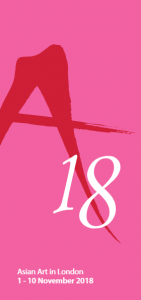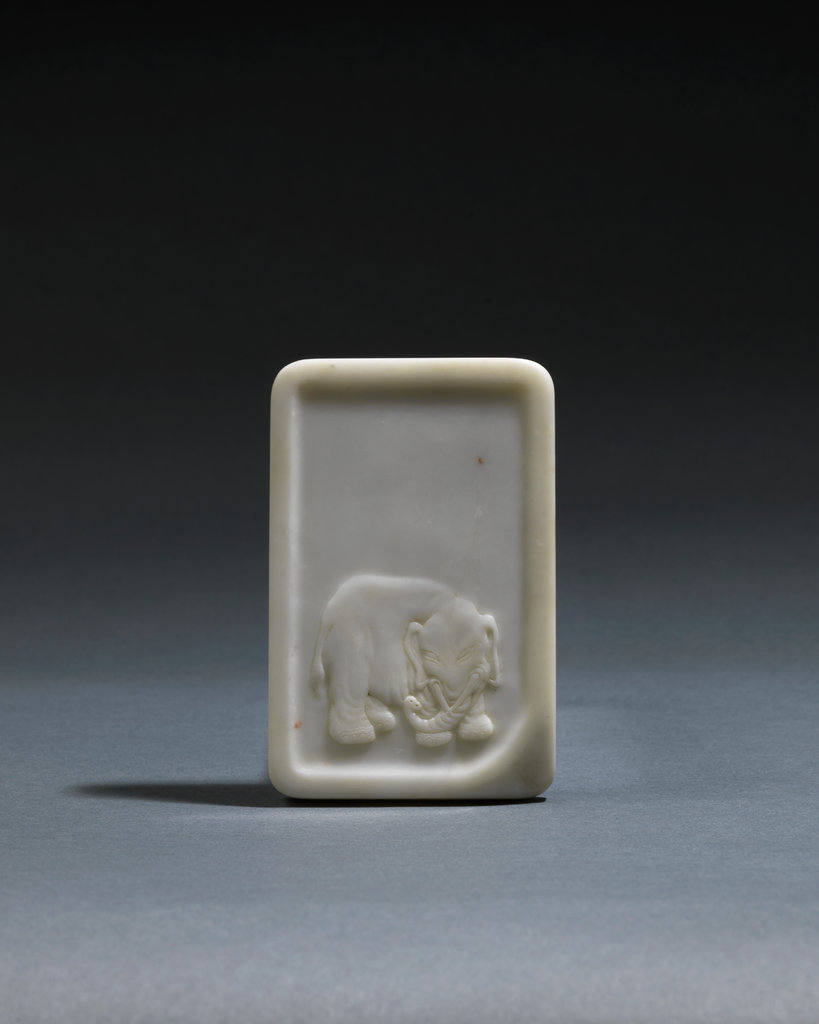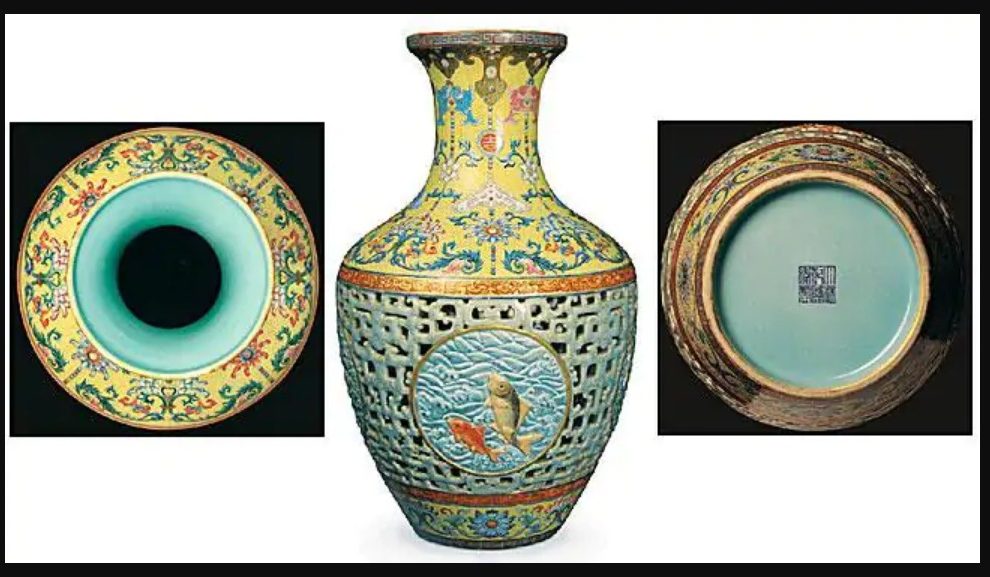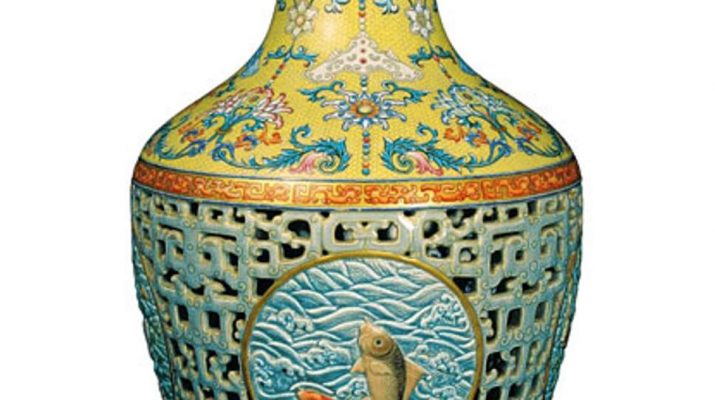寻觅真品:中国藏家全球网罗遗失文物
SCOTT REYBURN
2018年11月15日
伦敦——我们对艺术市场的观感,常常是由西方最著名画家、雕塑家作品的高昂价格来定义的。但是,另一种文化也可以激发惊人的销售额。
上个月在香港苏富比(Sotheby’s)拍卖行,一件18世纪的中国皇家御制“虞美人”彩瓷盌以2160万美元的价格成交。在同一场拍卖会上,一件也被认为属乾隆年间御制瓷器的华美吉庆有余花瓶则以1900万美元成交。
拍賣結果 吉慶玲瓏-乾隆洋彩透雕夾層玲瓏尊
2018年10月3日 | 上午 10:00 HKT | 香港
簡介
乾隆洋彩黃地粉青透龍夾層吉慶有餘玲瓏尊,頸上黃地錦上添花,溢洛可可洋風,四面浮雕開光,各綴雙魚栩栩如生,從外瓶鏤空夔龍紋,可窺內瓶青花纏枝花卉,妙然生趣,製作殊艱,誠乾隆重器。
3001
日本家族收藏
清乾隆 洋彩黃地粉青透龍夾層吉慶有餘玲瓏尊
《大清乾隆年製》藍料款
估價 50,000,000 — 70,000,000 港幣
拍品已售 149,091,000 港幣 成交價 (含買家佣金)













清乾隆 洋彩黃地粉青透龍夾層吉慶有餘玲瓏尊
《大清乾隆年製》藍料款
玲瓏尊撇口折沿,寬頸溜肩,黃地細描錦地,沿下環繪如意雲頭,渲染得宜,立體逼真,掛綴瓔珞串珠,其中四組配飾吉字,並有磬如祥蝠,且添盛綻番蓮四朵,橘紅亮藍,清新婉麗。另間飾雙魚四組,更添祥瑞,輔以卷延洋花,異風漫溢。縱然滿飾繁密,卻有條不紊,井然見序。斜肩下漸斂,器腹外層綠地紅龍之間,粉青描金鏤空夔紋,並綴四面浮雕開光,妙繪豐魚成雙,暢泳柔波微浪中,穿梭落花水藻間,其中鱖魚兩相對、紅鯉同游伴,悠然自得,栩栩如生。從鏤空間隙,可窺見內瓶仿明青花纏枝花卉,朵妍各異,妙然生趣。足上加綴黃地錦紋轉枝洋花,洋菊、銀蓮,雅致繾綣,與頸上飾紋相呼應。內頸及器底均施松石綠彩,底署藍料雙方框六字篆款,殊為罕稀。
高 40.8 公分,16 1/8 英寸
狀況報告
整體品相極佳,唯局部有火候稍過之象,尤其是肩沿黃彩、及瓶底年款外圍和內膽相應處松石綠彩有一圈約6公分之針孔暈散。
我們很高興為您提供上述拍品狀況報告。由於敝公司非專業修復人員,在此敦促您向其他專業修復人員索取諮詢,以獲得更詳盡、專業之報告。
準買家應該檢查每款拍品以確認其狀況,蘇富比所作的任何陳述均為專業主觀看法而非事實陳述。準買家應參考有關該拍賣的重要通知(見圖錄)。
相關資料
玲瓏尊撇口折沿,寬頸溜肩,黃地細描錦地,沿下環繪如意雲頭,渲染得宜,立體逼真,掛綴瓔珞串珠,其中四組配飾吉字,並有磬如祥蝠,且添盛綻番蓮四朵,橘紅亮藍,清新婉麗。另間飾雙魚四組,更添祥瑞,輔以卷延洋花,異風漫溢。縱然滿飾繁密,卻有條不紊,井然見序。斜肩下漸斂,器腹外層綠地紅龍之間,粉青描金鏤空夔紋,並綴四面浮雕開光,妙繪豐魚成雙,暢泳柔波微浪中,穿梭落花水藻間,其中鱖魚兩相對、紅鯉同游伴,悠然自得,栩栩如生。從鏤空間隙,可窺見內瓶仿明青花纏枝花卉,朵妍各異,妙然生趣。足上加綴黃地錦紋轉枝洋花,洋菊、銀蓮,雅致繾綣,與頸上飾紋相呼應。內頸及器底均施松石綠彩,底署藍料雙方框六字篆款,殊為罕稀。
高 40.8 公分,16 1/8 英寸
來源
山中商會,大阪、京都、紐約及波士頓,1905年
The American Art Association,紐約,1905年
日本私人收藏,1924年購自山中商會,此後家族傳承
展覽
《Antique and Modern Chinese and Japanese Objects of Art, Curios, Paintings, Prints, Textiles and Embroideries》,The American Art Galleries,紐約,1905年1月,編號352(附圖)
____________________________________________
透今覷古
康蕊君
乾隆一朝(1736-1795年),宮中崇尚新穎之品,務必精益求精,為悅龍顏、得君心,瓷匠費煞思量,方製得如此玲瓏尊之妙品佳器,盡顯神工鬼斧。華飾絢爛,兼具古今韻致,以妙趣巧思,昭揚乾隆盛世。此尊,及與此成對者,正如與其他洋彩瓷器,形飾獨特,別例無尋,應乃景德鎮供御特別燒造之品。
洋彩夾層玲瓏尊,當屬景德鎮御窰督陶官唐英(1682-1756年)晚年為乾隆皇帝創燒之新瓷。1740年代初,紫禁城御作坊內,以畫入瓷,生動趣真,珍品輩出,惟空間受限,器小而罕。景德鎮御窰廠規模卻無此礙,唐英為討君歡心,應天時、合地利,領導藝匠吐故納新,研製洋彩瓷器,強調紋飾獨特、千錘百煉,揉合各式繁複技巧及程序,或單或雙,五花八門,每器均集埏埴之大成。如此玲瓏尊一類,製作殊艱,耗料費工,讓唐英誠惶誠恐,嘗稟明聖上,雖有試燒,未得御旨,不敢多造。
鏤雕夔龍,源溯高古青銅禮器。東周(公元前770-256年)一朝,見證龍紋由繁漸簡,形態方折,爪足彷如逗點,頭首細小,只能憑龍目辨識(此洋彩尊上交龍則以描金點晴),縱然抽象,仍可看到𧃍龍交疊相纏。此類龍紋,東周青銅器上常見,工藝技法有浮雕、嵌錯或鏤空,例如北京故宮博物院藏公元前七至六世紀之方壺,龍耳飾紋繁複(收錄於《The Great Bronze Age of China》,大都會藝術博物館,紐約,1980年,編號67;圖一)。
論古典,器腹魚藻開光絕不遜於前。道家經典《莊子》中,有載莊周(公元前約369-約286年)時借魚寄意,其中「魚之樂」的無拘逍遙,後來更成為文人之夢,惜對帝君而言,談「魚之樂」不過閑坐論道,遙不可及。既有道家哲理,中國藝術品飾魚紋者,時有見之。此尊腹上綴魚兒成雙成對,泳於桃花、水藻之間,悠然自得,不禁讓人聯想到北宋(960-1127年)宮廷畫師劉寀筆下膾炙人口的《落花遊魚圖》卷(現為聖路易斯藝術博物館所藏,97:1926)。此器之魚,畫風獨特,別開生面,巧採浮雕,妙添麗彩,充分展現鱗片虹光的閃爍耀目。
外瓶粉青夾層玲瓏,同以趙宋(1127-1279年)為鑑。鏤孔套瓶,或取思南宋杭州官窰,老虎洞窰址出土兩膽瓶殘器,可為佐證(杜正賢編,《杭州老虎洞窰址瓷器精選》,北京,2002年,圖版24及25)。雖有先例,同處浙江的龍泉窰所製卻更為世所識,有鏤孔膽瓶及梅瓶傳世(見東方陶瓷學會展覽《China without Dragons. Rare Pieces from Oriental Ceramic Society Members》,倫敦蘇富比,2016年,編號96,圖錄即將於2018年下旬面世,圖二)。龍泉鏤空套瓶,如今學界雖大致定為十四至十五世紀初之物,清代帝王多或歸類為宋物。據乾隆八年(1743年)清宮造辨處檔案,記「洋彩黃地蓮環龍泉夾花玲瓏罇一對……傳旨著供各配架座」,可悉相類瓷器昔時也以「龍泉」稱之。
遙想乾隆當時,遠觀此尊,或已暗自嘆詠,驀然窺得內藏瓷瓶,滿綴青花纏枝花卉,妍姿各異,定必詫為奇事。內瓶所擬飾紋,誠永宣二朝景德鎮御窰經典,風行之極,難相匹敵,乾隆年間仿造不厭、珍賞不已。此類明初青花纏枝花卉紋,可參考北京故宮博物院清宮舊藏水注,其器腹飾樣與此類同(見《故宮博物院藏文物珍品大系.青花釉裏紅(上)》,上海,2000年,圖版119;圖三),並可比較清宮舊藏清代仿明青花纏枝花卉紋瓶,署乾隆年製款(見《故宮博物院藏文物珍品大系.青花釉裏紅(下)》,上海,2000年,圖版136)。
此玲瓏尊肩上的黃地錦地洋花紋,起源卻迥然不同。乾隆一朝,高宗復循先祖康熙皇帝(1662-1722年在位)之步履,召請來華傳教士進宮供職獻技,引入洋風西法,對當朝藝作影響無容置疑。器上曲卷葉紋,顯然受法國帝君路易十五(1715-1774年在位)統治時西方流行之洛可可風影響。石貝紋飾(法文 Rocaille),因園林華美石雕得名,後來統稱為洛可可,1730年代在法國盛極一時,後更風靡整個歐洲,為室內設計、銀作及瓷器裝飾迎來新貌。洛可可一詞,初用於法國藝術家布雪(Francois Boucher)設計的屏風上,所綴之紋,揉合貝殼、卷葉等圖案,錦飾瑰麗,人所喜慕,傲領十八世紀上半葉之潮流,陶染之處,無遠弗屆,遙及北京御瓷作坊。如此玲瓏尊上所飾卷葉,多稱為苕茛,或借鑑法國設計師兼畫家 Alexis Peyrotte(1699-1769年)之作。Peyrotte 曾參與凡爾賽宮、楓丹白露宮及馬爾利莊園(Chateau de Marly)等之室內設計,尤以「中國風(Chinoiserie)」為人稱著。參考 Peyrotte 一幅苕茛葉飾紋銅版畫,和此尊肩上圖案尤為相近,版畫創作於1740年,與此玲瓏尊年代幾乎一致(圖四,Cooper Hewitt,史密森尼設計博物館)。
雖以西風入瓷,藝匠卻未循歐洲常見之不對稱設計。瓶頸環飾洋花卷葉,配綴串珠,以及雙魚、吉慶、如意雲頭等中國傳統圖案,猶如項鍊規整對稱。瓔珞圓珠巧添光點,加上如意雲頭的漸層渲染,讓玲瓏尊更形立體。
乾隆八年(1743年),唐英上奏稱他「新擬得夾層玲瓏、交泰等瓶共九種」,又道「工料不無過費,故未敢多造」,得皇上批准才「再行成對燒造」(廖寶秀,《華麗彩瓷:乾隆洋彩》,台北,2008年,頁27始)。乾隆帝批閱後要求新式瓷器「俱要成對,如不能成對,即將各樣燒造」,但指「不必照隨常磁器一樣多燒,嗣後按節進十數件」。由此可悉,當時有後配成對之事,這或可解釋為何兩尊成對、落款有別之惑。
與此玲瓏尊成對者,現為私人收藏。該瓶原於2010年11月11日,在英國米德塞克斯郡位於賴斯的班布里奇拍賣行(Bainbridge’s)以四千三百萬英鎊的高價拍出(編號800,連佣金五千一百六十萬英鎊),刷新世界紀錄,消息轟動全球,頓成報章頭條。然而交易最後落空,要多待兩年才經邦瀚斯以私人洽購形式促成其事。當日原以為該瓶乃傳世孤品,如今得見此瓶,方知世間有玲瓏對尊。該器底署較常見之青花篆款,但除此年款局部,幾無二致。
此玲瓏尊所落藍料雙方框六字篆款,極為鮮見,有別於一般洋彩器上之藍料雙方框四字款。松石綠地藍料款雖罕,仍有例可鑑,如一對嬰戲圖瓶,分別藏於兩岸故宮(見《清宮中琺瑯彩瓷特展》,台北,1992年,編號146,及《故宮博物院藏文物珍品全集.粉彩.琺瑯彩》,香港,1999年,圖版91)。
早於二十世紀初,此尊已現身紐約展售場上,距今已逾百年(圖五及六)。在過去近一個世紀,為一家族所藏,潛形匿跡。論紋飾搭配,此對玲瓏尊舉世無雙,但台北故宮有藏器形與此相同之對瓶,可資比較,其「龍泉」鏤空也與此吻合,卻缺描金,器腹開光畫山水,浮雕欠奉,瓶頸同畫洋花,隙地卻以紅代黃(其一見廖寶秀,前述出處,編號69;該瓶又收錄在《十全乾隆—清高宗的藝術品味》,台北,2013年,圖版II-3.32;圖七)。台北對瓶原為壽皇殿陳設器,壽皇殿位處景山正北,與正南之紫禁城坐落同一中軸上,乃歷代清帝供奉祖上之所。
台北故宮博物院另藏三件洋紅地錦上添花龍泉描金夾層玲瓏膽瓶,其中兩瓶成對原佇端凝殿,另一則存紫禁城養心殿內(其一見廖寶秀,前述出處,編號68)。
觀此尊之配色、紋樣、風格、技巧,似專為乾隆皇帝而設。上承高古青銅禮器,隱含先秦哲理之道,揉合北宋繪畫、南宋瓷器、明代御窰風格,此器借歷代輝煌,照證滿清國朝天威。玲瓏尊上之洋花卷草,取思洛可可石貝飾紋,蘊異國情調,述說當今帝皇效法聖祖的積極進取,廣納舶來新知巧思,不甘故步自封。雍正帝(1723-1735年)開御瓷祥瑞之風,自此禎符俯拾皆是,此尊上綴吉慶有餘,不無敬父尊祖之意。
舞袖迎風-御製琺瑯彩虞美人題詩盌
2018年10月3日 | 上午 11:00 HKT | 香港
簡介 清乾隆御製琺瑯彩虞美人題詩盌
乾隆御製琺瑯彩虞美人盌,纖花盛綻,石半掩、蝶縈繞,並題前人佳句,詠妍姿雅貌,盌心加綴佛手瑞果,更形清朗,私人珍藏中絕無僅有。琺瑯彩畫虞美人,除此僅見台北故宮博物院藏雍正盤一對,尤為難得。
清乾隆 御製琺瑯彩虞美人題詩盌
《乾隆年製》藍料款
「佳麗」、「翠鋪」、「霞映」印
拍品已售 169,413,000 港幣 成交價 (含買家佣金)







此盌器形雅正,弧壁渾圓略撇,胎質細密,均淨如雪。從景德鎮御窰跋涉上送京師,宮中妙畫琺瑯彩,外壁寫生虞美人,黃自矜持、白怯羞緋、紅恃嬌縱、紫尚雅風,翠葉間,纖花或含蕾、或盛綻,曲莖搖曳微風中,石半掩、蝶縈繞,渲染描繪細膩如生。另一面墨題明人徐桂〈詠虞美人草〉詩二句,曰:「迎風似逐歌聲起,宿雨那經舞袖垂」,既詠虞美人隨風起舞之妍姿雅貌,又是借花懷古。詩前有「佳麗」,後添「翠鋪」與「霞映」,共紅料印三枚。盌心加綴三多瑞果,更顯清朗秀逸。足底雙方框內藍料書「乾隆年製」四字宋體款。
11.8 公分,4 5/8 英寸
狀況報告
此盌品相極佳。
我們很高興為您提供上述拍品狀況報告。由於敝公司非專業修復人員,在此敦促您向其他專業修復人員索取諮詢,以獲得更詳盡、專業之報告。
準買家應該檢查每款拍品以確認其狀況,蘇富比所作的任何陳述均為專業主觀看法而非事實陳述。準買家應參考有關該拍賣的重要通知(見圖錄)。
相關資料
此盌器形雅正,弧壁渾圓略撇,胎質細密,均淨如雪。從景德鎮御窰跋涉上送京師,宮中妙畫琺瑯彩,外壁寫生虞美人,黃自矜持、白怯羞緋、紅恃嬌縱、紫尚雅風,翠葉間,纖花或含蕾、或盛綻,曲莖搖曳微風中,石半掩、蝶縈繞,渲染描繪細膩如生。另一面墨題明人徐桂〈詠虞美人草〉詩二句,曰:「迎風似逐歌聲起,宿雨那經舞袖垂」,既詠虞美人隨風起舞之妍姿雅貌,又是借花懷古。詩前有「佳麗」,後添「翠鋪」與「霞映」,共紅料印三枚。盌心加綴三多瑞果,更顯清朗秀逸。足底雙方框內藍料書「乾隆年製」四字宋體款。
來源:
傳法國私人收藏,集成於二十世紀初
香港蘇富比2003年10月26日,編號21
—————————————————————————————————————————
舞袖迎風虞美人
康蕊君
此琺瑯彩盌,上繪虞美人花淡雅雋永,墨書題寫詩文二句,流麗秀朗。芬芳背後,借花懷古,訴說歷代詩文傳頌之史,憶一代豪傑赤膽、愛侶丹心。
外壁口沿下墨題詩句:「迎風似逐歌聲起,宿雨那經舞袖垂」,藉虞美人的纖瓣嫩葉,側寫絕色佳麗。乾隆帝(1736-1795年在位)自幼研習漢人傳統文化,熟稔詩詞、深諳史事,對此詩之以花詠史,必然瞭如指掌。
據漢朝史學家司馬遷(公元前145至約90年)所著經典《史記.本紀.項羽本紀》,楚國名將項羽(公元前232-202年)率諸侯滅秦(公元前221-206),遂復楚國,自號西楚霸王。劉邦(公元前256-195年)稱漢王,建立漢朝(公元前206至公元220年)政權,與項羽軍事角力多年,至公元前202年垓下之戰(今安徽北部),項羽烏江自刎方止,史稱楚漢相爭。司馬遷寫道:「項王軍壁垓下,兵少食盡,漢軍及諸侯兵圍之數重。夜聞漢軍四面皆楚歌,項王乃大驚曰:『漢皆已得楚乎?是何楚人之多也!』項王則夜起,飲帳中。有美人名虞,常幸從;駿馬名騅,常騎之。於是項王乃悲歌慨,自為詩曰:『力拔山兮氣蓋世,時不利兮騅不逝。騅不逝兮可奈何,虞兮虞兮奈若何!』歌數闋,美人和之。項王泣數行下,左右皆泣,莫能仰視。」司馬遷錄下一代英雄霸王,窮途末路,忽聞四面楚歌,以為漢軍攻克楚地,千里良馬也無力前行,遑恐氣數已盡,與愛姬分離在即,難掩悲淒,終於烏江自刎(英譯見 Burton Watson,Cyril Birch 編,《Anthology of Chinese Literature》,Harmondsworth,1967 [1965] 年,頁142)。
項羽與其寵妾虞姬(公元前202年卒)淒美的愛情故事,自古至今,為世所傳,受歷代詩人頌詠,又改編成戲曲、電影、劇集以至電子游戲。此盌上墨題明末詩人徐桂〈詠虞美人草〉二句,言及楚歌之聲,暗示鴛侶命數。
據後世典籍,虞美人以詩和應項羽的〈垓下歌〉,舞劍殉情楚帳中。虞姬之情深義重、忠貞不二,後人稱頌,被視為古代美人之一。傳說安徽省宿州之東靈璧縣垓下虞姬香銷之處,朵兒遍地,此花遂得「虞美人」雅名。如今該地因美人之名,訪客如雲。
虞美人(又名滿園春),瓣葉皺且薄,仿如蝶翅,青蕾花開便褪,綠莖細而有毛,形態與別不同,易於識辨。花卉繪畫,早於趙宋已有,至清初,惲壽平(1633-1690年)擅畫花,舒卷開冊,筆下淡彩沒骨,嬌妍千姿,自成一派,復興花卉寫生之風,影響深遠,誠中國花卉繪畫名家。所繪虞美人,花瓣透薄,靈動如舞,啟迪康雍年間多位畫家,如王武(1632-1690年)、惲冰(1670-1710年)、馬元馭(約1669-1722年)、雛一桂(1686-1772年)等,同繪虞美人之輕巧婉約,多見於十二月令圖冊,展示季節華葩。
虞美人纖細柔雅,卻罕見繪飾於瓷器之上。早期雛例可見台北故宮博物院藏康熙御製瓷胎畫琺瑯虞美人花盌,施紫紅為地,濃彩艷姿,略微矯揉,見《神筆丹青:郎世寧來華三百年特展》,台北,2015年,編號I-17。
雍正一朝,宮中琺瑯作以虞美人花入瓷,或僅只一回,花姿形態較接近此盌。參見台北故宮博物院藏琺瑯彩虞美人碟一對,同繪花綻秀石間,二器佈局略異,少半面分別墨字題寫「迎風似逐歌聲起」及「宿雨那經舞袖垂」,底書「雍正年製」款,其一著錄同上,編號II-05,另一則刊於《清宮中琺瑯彩瓷特展》,台北,1992年,編號98(圖一)。
觀此盌紋飾題詩,雖明顯以雍正例為鑑,然繪風迥異,各有千秋。雍正對碟,虞美人花稍形敦實,沒有突出瓣之透薄、莖之輕盈,有別於此乾隆盌上,嫩葉曲莖,茂密橫生,忽然微風輕吹,纖瓣朵兒妙舞翩翩,活靈活現,意趣盎然。
清代琺瑯彩器,瓷胎出江西,由景德鎮窰燒成之均淨白瓷,從長江之南,跋涉送至北京宮中作坊,施彩二次入窰復燒方成。琺瑯彩料,初由洋人引入,所繪紋飾雅緻,成器悅目賞心,罕稀至極,問鼎清代瓷珍之冠。禁宮琺瑯作坊,毗鄰天子寢宮,畫師所受監督之嚴、壓力之大,空前絕後。相比景德鎮御窰廠,即使上供御用之品,也會大量燒製,反之,琺瑯作位處紫禁城中,為免滋擾宮廷生活,加上地方之限,規模極小,畫師必須因材施藝、以意創造,一器一畫,變化多端,無一相同,精妙絕倫之處,難出其右,讓人嘆為觀止,卻又因其獨特,極為罕有。
琺瑯彩盌所施彩料乃為此盌特別調製,配以悉心佈局,風格清新朗逸。景德鎮御窰雖有燒造虞美人花瓷器,飾樣大同小異,幾乎如一,繪施為量燒而研發之粉彩,縱然瑰麗,絕不能與此盌相提並論。粉彩例可參考 James D. Thornton 博士舊藏粉彩虞美人對盌,售於香港佳士得2017年11月29日,編號2806。
康熙一朝,宮廷畫家、藝匠、科學家在紫禁城中專精覃思,鑽研新知巧技,試煉各式材料,一時間御作坊宛如實驗室。為促使大清國追上國際科學水平,康熙帝詔旨洋人進京,其中多屬歐人,在宮中傳授科技新知。奪嫡繼位之雍正帝,卻對宮中洋士存疑,除寥寥數人悉遂宮外。留下來的洋人,包括意大利傳教士郎世寧(1688-1766年),擅長繪事,學貫中西畫風,以中國傳統佈局,配合歐洲細緻筆觸,創出別樹一幟的作品。郎世寧的花鳥動物,借鑑中國傳統,寫生出神入化,大悅君心。雖對中國繪畫整體發展影響甚微,在紫禁城內,郎世寧及其他歐洲人卻啟迪同坊共作者,向宮廷畫家展示舶來西風。
郎世寧〈畫仙萼長春〉冊,繪華葩盛綻,或是花鳥爭妍,多採中國繪畫常見的不對稱佈局,卻融合西洋技法,精緻入微、毫微畢現。其中一頁,繪蝴蝶蘭花倚石盛放,蔭下虞人花綻紅,筆觸細膩,栩栩如生。宮中琺瑯作盌之虞美人花,精細微處,瓣脈嫩蕊,清晰流露郎世寧丹青倩影(圖二)。
同是寫生虞美人,雍、乾二朝例的最大分別,在於後者花卉,沒有因盌壁空間之限而迥避,反而略加放大,任由邊沿裁去彎莖曲瓣,讓花兒更形立體,彷彿躍然器上。中國繪畫卷軸,紙本絹上,早已有採此技法,以顯景物逼真,至今亦然,廣告常見。景德鎮窰也有過枝花,紋樣從外而內,翻壁而過,飾至器心,看似與前述類同,概念卻異,若相提並論,無疑貶低此琺瑯彩盌上佈局不全不缺、捨少求真之巧思。
乾隆年間所製瓷胎畫琺瑯器中,以虞美人為飾者,只此盌而已,絕無僅有。此器盌心並繪畫三多瑞果,佈局隨意悅目,尤為難得。除台北故宮博物院所藏,題詩花卉紋盌類例極罕。參見前述1992年展覽圖錄,編號57、58與61,最後一器盌心也綴折枝瑞果。一般瓷盌及盤,若器外繪圖如畫,內多留白,相反外色地錦上添花、紋樣規謹者,器內則常添繪飾,例見台北故宮博物院藏瓷胎琺瑯錦上添花黃地對碟,碟內隨意畫瓜果數種,收錄於廖寶秀,《華麗彩瓷:乾隆洋彩》展覽圖錄,台北,2008年,編號91。

受经济增长的鼓舞,中国经销商和收藏家自2000年代中期开始一直在为他们国家过去的精美艺术品出高价。但今年来,随着中国经济增长放缓,古董市场开始沉稳起来。
香港苏富比中国艺术品秋拍的299件拍品中只有不到一半找到了买家。在对乾隆吉庆有余瓶的宣传中,拍卖行称它与2010年在伦敦一家小拍卖行拍出天价5160万英镑的花瓶原属一对,如今重现人间。当时那名北京的投标方始终未为该花瓶付款,2013年花瓶被私下卖给了另一个买家,售价在3200万美元到4000万美元之间。这只据信为一对中“另一半”的花瓶此次在香港拍出的1900万美元,要比之前的价格低很多。
3075 AN OUTSTANDING AND HIGHLY IMPORTANT MASSIVE GILT-BRONZE FIGURE OF A SEATED SHAKYAMUNI BUDDHA
MARK AND PERIOD OF YONGLE
LOT SOLD. 236,440,000 HKD
AN OUTSTANDING AND HIGHLY IMPORTANT MASSIVE GILT-BRONZE FIGURE OF A SEATED SHAKYAMUNI BUDDHA
MARK AND PERIOD OF YONGLE

MARK AND PERIOD OF YONGLE

MARK AND PERIOD OF YONGLE

MARK AND PERIOD OF YONGLE

MARK AND PERIOD OF YONGLE
well-cast and portrayed seated in vajraparyankasana, the right hand held in bhumisparshamudra and the left in dhyanamudra, wearing a pleated robe draped over the left shoulder with the undergarment gathered at the chest, the serene face with downcast eyes and a meditative expression, flanked by a pair of long pendulous ears cut with vertical slots, the head and domed ushnisha covered with tight curls and surmounted by an ovoid jewel, all supported on a double lotus pedestal with beaded edges and inscribed Da Ming Yongle nian shi, the base sealed and engraved with a visvavajra
54.5 cm., 21 1/2 in.
CONDITION REPORT
The figure is in overall good condition with typical minute oxidization to the gilding in areas, some visible on the face of the figure and around the neck and on the sole of one foot. There is also some expected general light brusing and loss of gilding on the extremities, especially to the ushnisha, the front and tips of some the fingers and to the beaded borders encircling the lotus base. There are a few minor dents to the platform of the lotus base. There are two areas of repair, one of 3.5 cm the other of 3.2 cm to the footrim of the lotus base, the first on the bottom right below the figures left knee (visible on the main catalogue photograph), the second to the rear left of the figure, both probably from the original casting process, together with additional minor casting faults around the footrim. The plate under the base is unsealed and has been re-affixed. There are two cracks, one of 5 cm., the other of 3 cm., and expected significant dents and bruises together with traces of a red painted lacquer on the base plate. The hair has traces of blue pigment remaining near the ushnisha.
PROVENANCE
An old Italian private collection since the 1960s.
An Italian private collection, Genoa, acquired in 1990.
Thence by family descent.
CATALOGUE NOTE
The Shakya Sage
An Exceptional Yongle Gilt-Bronze Buddha
David Weldon
CATALOGUE NOTE
The Shakya Sage
An Exceptional Yongle Gilt-Bronze Buddha
David Weldon
The artists working in the imperial workshops during the Yongle period remain anonymous, but their gilt bronze sculptures have now become recognised as among the most important works of art from the Buddhist world, characterised by faultless casting and rich golden hue. Some fifty-four examples bearing the inscription da Ming Yongle nian shi (‘bestowed in the Yongle era of the great Ming’) have been documented in Tibetan monastery collections; see Ulrich von Schroeder, Buddhist Sculptures in Tibet, Hong Kong, 2001, vol. II, pp. 1237-91. These works have survived in Tibet due to imperial patronage lavished on Tibetan hierarchs and monasteries during the reign of the Yongle emperor. Zhu Di (1360-1424) pursued a bountiful relationship with Tibetan religious leaders during his reign as Yongle (Perpetual Happiness) emperor, but not all bronzes from his workshops were cast as gifts to Tibetans, nor were they all made following the strict Tibetan iconographic canons. A relatively large group depict Chinese Buddhist iconography that was not popular in Tibet, such as the Speelman Udayana Buddha, sold in these rooms, 7th October 2006, lot 803, and the Markbreiter Marichi and Chintamanichakra Avalokitesvara, also sold in these rooms, 7th October 2010, lot 2141 and 2143. With the emperor’s espousal of Buddhism it may be assumed that works were also cast to be worshipped locally, especially those iconographic subjects that depict deities from familiar Chinese Buddhist traditions. The present gilt bronze Buddha shows no signs of having been ritually painted as is normal in Tibetan Buddhist practise, and it could be that the sculpture was made in the imperial workshops for local worship rather than as a gift to a Tibetan hierarch.
The stylistic origin of the Yongle Buddha can be traced to the Yuan dynasty when Tibetan Buddhism became the court religion. Early fourteenth century woodblocks made for the monastery of Yangshen Yuan, Hangzhou, are evidence of a new style appearing in Chinese Buddhist art, see Heather Stoddard Karmay, Early Sino-Tibetan Art, Warminster, 1975, pp. 47-50, pls. 26, 29, 30. The gently smiling faces, full rounded figures and tiered thrones in these woodblock prints reflect the current Newar styles favoured in Tibet, and introduced into China by Nepalese artists such as Aniko (1244-1306). Yongle sculptors could almost have used these illustrations as a blueprint for works such as the Shakyamuni Buddha shrine in the British Museum, W. Zwalf ed., Buddhism: Art and Faith, London, 1985, frontispiece, and the Speelman shrine, sold in these rooms, 7th October 2006, lot 808 (fig. 1). The present Buddha follows much the same style but has no additional throne, and differs in subtle stylistic detail from the British Museum and the Speelman examples: the drape of the Buddha’s robe over the lotus seat gathers linearly in front of the legs, in the manner of the Speelman Vajradhara, sold ibid., lot 811, rather than spreading in undulating folds. And an incised line decorates the hem of the Buddha’s robe throughout, a detail not encountered elsewhere in the oeuvre. Apart from these minor differences the classic Yongle style is evident in the loosely folded cloth over the legs and torso, the ubiquitous drape of the robe falling from the right shoulder, and the bulbous lotus petals of the pedestal, evenly spaced around the base between rows of rounded pearls.
Other than the monumental gilt-bronze Padmapani in the Qinghai Museum, see The Palace Museum, Splendors from the Yongle (1403-1424) and Xuande (1426-1435) Reigns of China’s Ming Dynasty, Beijing, 2010, p. 253, pl. 126, and the Cernuschi Museum example, Ulrich von Schroeder, Indo-Tibetan Bronzes, Hong Kong, 1981, p. 531. Pl. 151E, this Buddha is one of largest extant Yongle marked bronze sculptures, comparable in size to the important Xuande Amitayus, Christie’s Hong Kong, May 31, 2010, lot 1961. The iconographic form, in which the historical Buddha is presented, unadorned but for a simple robe and seated in the earth-touching gesture (bhumishparsha mudra), is relatively uncommon in the corpus of Yongle bronzes, with only one small example recorded in von Schroeder’s survey of Tibetan monastery collections, Buddhist Sculptures in Tibet, op. cit., p. 1280, pl. 358A. Other small examples include the rare Nepalese style Yongle Buddha in the Markbreiter Collection, sold in these rooms, 7th October 2010, lot 2142 and a classic version in the Palace Museum, Splendors from the Yongle (1403-1424) and Xuande (1426-1435) Reigns of China’s Ming Dynasty, op. cit., p. 244, pl. 118, but the present example is by far the largest yet recorded.
The Buddha’s earth-touching gesture recalls an episode from his spiritual biography in which he triumphs over Mara (maravijaya) just prior to his enlightenment. Having vowed to remain in meditation until he penetrated the mysteries of existence, Shakyamuni was visited by Mara, a demon associated with the veils and distractions of mundane existence. The Buddha remained unmoved by all the pleasant and unpleasant distractions with which Mara sought to deflect him from his goal. According to some traditional accounts, Mara’s final assault consisted of an attempt to undermine the bodhisattva’s sense of worthiness by questioning Shakyamuni’s entitlement to seek the lofty goal of spiritual enlightenment and freedom from rebirth. Aided by spirits who reminded him of the countless compassionate efforts he had made on behalf of sentient beings throughout his many animal and human incarnations, Shakyamuni recognised that it was his destiny to be poised on the threshold of enlightenment. In response to Mara’s query, Shakyamuni moved his right hand from his lap to the ground before him, stating, ‘the earth is my witness’. This act of unwavering resolve caused Mara and his army of demons and temptresses to disperse, leaving Shakyamuni to experience his great enlightenment. The episode embodied in this rare Yongle gilt bronze took place upon the adamantine site (vajrasana) at Bodh Gaya, which by tradition was especially empowered to expedite his enlightenment.
“人们非常挑剔,”伦敦佳士得(Christie’s)中国艺术资深专家何玉清(Kate Hunt)说,这家拍卖行周二举办了一场拍卖会,属于名为“亚洲艺术在伦敦”(Asian Arts in London)的年度系列展览、拍卖会与讲座中的一部分。
埃斯卡纳齐最近将一件宋代木刻佛像卖给了阿布扎比卢浮宫。

Asian Art in London 1 – 10 November 2018 Asian Art in London
1 – 10 November 2018

佳士得的这场拍卖拍得870万英镑,320件拍品成交的将将超过一半,反映了香港市场的挑剔。
“价格泡沫在2015年破裂了,”何玉清提到了中国股市暴跌那一年。她还说,北京最近缩紧资金流出,使得中国买家很难在欧美拍卖会上为顶级拍品买单。“但市场已经成熟,”她说。“并且中国人喜欢东西有老英国出身。”
随着自己国家的市场充斥伪造品,中国人向欧洲寻求那些有真品保证,且历史上归他们所有的艺术品。
伦敦佳士得的现场拍卖包括了来自著名东方艺术学者詹宁斯(Soame Jenyns)的24件收藏,詹宁斯于1931至1968年担任大英博物馆(British Museum)策展人。对于涌入这些伦敦拍卖会的中国经销商来说,这是一个诱人的出处,并且,本周在该城有很多拍卖会有待发现,他们用手电筒照射着瓷碗和花瓶,用手机拍摄照片。
该系列拍品中的明星无疑是一件15世纪的镀金青铜佛坐像,估价15万至20万英镑。据佳士得称,这件拍品的亮点在于铸造的品质,此外还罕见地保住了原有的密封底座,它以超过190万英镑的全场最高价拍给了一位亚洲竞拍者。
在“亚洲艺术在伦敦”布展的经销商罗杰·凯弗恩(Roger Keverne)当时在拍卖现场。“我的两位中国客户询问了这件东西。他们做复兴佛教的事已经有一段时间了,”凯弗恩说。“文化大革命企图彻底消灭它。但他们现在想要提升这种文化。这是一种回归。”
伦敦经销商觉是轩的一场展览上,一件刻有大象图案的清代砚台。

中国买家近年开始关注佛教造像这个冷僻的领域,2014年这种雕像曾创下3000万美元的拍卖纪录。这种热情在佳士得专家何玉清看来是市场成熟的表现。
参加“亚洲艺术在伦敦”的43家经销商之一埃斯卡纳齐(Eskenazi)公司创始人朱塞佩·埃斯卡纳齐(Giuseppe Eskenazi)说,他从1972年开始就在购买中国佛教造像了。
“我主要卖给英国和美国的藏家,也卖给美术馆,”埃斯卡纳齐说。“它在中国没有人欣赏。不受重视。但现在年轻的中国藏家迷恋它。”
埃斯卡纳齐最近将一件威严的宋代木刻佛像卖给了阿布扎比卢浮宫。这件文物在画廊2014年的一次展览中标价2500万美元。本周,该画廊展出了中国历史上的混乱时期魏晋南北朝(3世纪~6世纪)的文物,它们来自好莱坞的艺人经纪人诺曼·库兰(Norman Kurland)四十余年的收藏。
库兰的收藏主要集中在陶俑——传统上,中国人认为拥有陶俑是不吉利的——以及安详的石刻佛雕,可以被视作一种偏西方学者的口味,但在周一晚上的观展活动中,有许多中国人慕名而来。画廊方面表示,截至周三,38件展出文物当中已经有数件卖给了中国藏家,包括三件佛教文物。其中有一尊6世纪的石灰石半身佛像,售价超过100万美元。
伦敦其他的文物经销商也举办了各种专题展览。觉是轩(Priestley & Ferraro)展出了20件以大象为主题的中国艺术品。在云南,这些动物是保护物种,长期以来,它们因坚定稳重的品质而一直受到中国文化的推崇。
英国威立士拍卖行拍卖的一件宋代青白瓷碗。

在该展览一些价格没有那么贵的文物中,一件年代不详、刻有大象图案的美丽砚台迅速以1.5万英镑的价格售出。
觉是轩的联合创始人戴维·普里斯特利(David Priestley)说:“常见的交易商都在这里,但他们可买的东西不多。”他还说,“中国这台吸尘器正在把东西从欧洲吸走。”
随着美国不再威胁要对中国古董征收25%的进口关税——此举可能有利于欧洲的艺术品贸易——伦敦高品质古董供应越来越紧张。
回归中国的古董通常很难再回来。英国拍卖行威立士(Woolley & Wallis)的亚洲艺术专家约翰·埃克斯福德(John Axford)说,那些从中国来到英国的文物,往往真假难辨。
“你必须非常小心才行。有很多赝品都有“古老”的标签和收据,”埃克斯福特在威立士于伦敦举行的拍卖前的预展上说,他展示了一只宋代青白瓷碗,估价在2000到3000英镑之间。这件文物来自一个西班牙的藏家,带有纽约交易商詹姆斯·劳利(James Lally)的标签和收据。为了辨明真伪,埃克斯福德打了许多电话,发了许多电子邮件,他给劳利打去电话,对方证实了这个青白瓷碗是其藏品中的“老朋友”。
“‘确定真假’是最难的部分,”埃克斯福德说。
翻译:Shuhua、杜然
BBC antiques expert said £53million Chinese vase was a ‘very clever fake’
Friday 12 November 2010 14:01
A vase that was sold for £53 million at auction was called a fake by a BBC expert on an antiques programme, it was claimed today.
The 18th-century piece of Qianlong-era porcelain smashed the world record for Chinese artwork at auction last night, leaving its “utterly normal” owners in shock.
The vase’s former owner, who recently died, had taken the piece onto Going For A Song about 40 years ago and an unnamed expert had declared it a “very clever reproduction”.

David Reay, the manager of Bainbridges auction house in Ruislip, said: “The piece was sold by a 70-year-old woman and her son and daughter. We were clearing her brother’s house after he died and I looked at the vase and said: Oh, that looks nice’. It had just sat on the bookcase doing absolutely nothing.
“They told me it had been valued at just £800 two months earlier. They also told me the owner had taken it on Going For A Song on the BBC about 40 years ago. He was told it was a very clever reproduction.”

It is believed the expert could have been the late Arthur Negus who was the resident expert and valuer on Going For A Song, forerunner of the Antiques Roadshow, between 1966 and 1976. A panel of experts would examine the objects and give their opinion on date and value. Negus would then present the actual age and worth. A BBC spokesman said: “We are not in a position to add anything or comment at this point.”
Auction house staff today described the brother and sister, who wish to remain anonymous, as “utterly normal” and told how they had to be taken outside for some air after the sale.
The piece had been expected to fetch between £800,000 and £1.2 million. Peggy Bates, 61, who works for Bainbridge’s and was at the sale, said: “The room was crackling with excitement. The couple were down in the middle of the audience but no one knew.”
Mr Reay added: “She told me she wished it had happened 30 years ago.” Ms Bates told how the pair remembered the vase as “just an ornament”. It is thought to have been in the family since the Thirties and was passed down from someone who did a lot of travelling.
The vase was sold after 30 minutes of furious bidding to a Chinese man, said to be a Beijing-based agent, who refused to comment after the sale.
Standing 16 inches tall and elaborately carved, the vase is thought to date from about 1740, the time of Qianlong, the fourth emperor of the Qing dynasty.
The hammer fell at £43 million but the total price, including commission and VAT, was £53,105,000.
Auctioneer Peter Bainbridge returned to the rostrum 30 minutes later and said: “Come on now ladies and gentlemen, let’s get back to business.” Ms Bates added: “He carried on with the furniture sale. He was selling items for £50 straight after selling one for £50 million.”
A vase found in a house clearance in London has been sold for £43m, thought to be a record for any Chinese artwork.
The 18th Century Qianlong porcelain piece, found in Pinner, had been estimated to fetch up to £1.2m for the brother and sister who inherited it.
Ivan Macquisten, editor of Antiques Trade Gazette, said the vase would have been made for the Qianlong emperor.
The 16in high vase is yellow and sky blue in colour with a fish motif on the front and a perforated outer wall.
The private buyer – who is thought to have come from the Chinese mainland – paid £43m, with an additional premium of £8.6m to go to the auctioneer.
The auctioneers found the vase in the bungalow which the brother and sister inherited from an uncle.
‘Atmosphere electric’
Mr Macquisten said there was a “queue of dealers and collectors” to see the vase.
He said: “It dates to between mid to late 18th Century and it would have been made for the Qianlong emperor.
“He was the emperor in China when China was at its zenith, effectively creating the empire you see today. And this is one of the great works made for one of his palaces.”

Peter Bainbridge, from Bainbridge’s auctioneers, based in Ruislip, said the value of the vase was realised when items were being unpacked to be catalogued for sale.
“When it was on the shelves ready to be catalogued our consultant valuer paused at it and said ‘I have a feeling this is quite interesting’.
He said the atmosphere at the auction was “electric”.
“The Chinese contingent had been in very smart sale rooms all week and I think found it rather curious to come out here, and mix amongst buyers who we were selling fridges and cookers to, and the like.
“Then the silence wrapped itself around the sale room as we progressed through this very exciting bidding.”
Describing the reaction of the brother and sister duo Helen Porter, from the auction house, said: “They were hopeful but they didn’t dare believe until the hammer went down.
“When it did, the sister had to go out of the room and have a breath of fresh air.”
The ceramic vase was made during the reign of the fourth emperor in the Qing dynasty who ruled the empire from 1735 to 1796.
It is thought the vase left China in about 1860 and was acquired by an English family during the 1930s but how it made its way to the bungalow in Pinner is a mystery, the auctioneer said.
A posting on the auctioneer’s blog said: “It is a masterpiece. If only it could talk.”
British family’s Chinese vase fetches $83-million at auction
LONDON GLOBE AND MAIL UPDATE
PUBLISHED NOVEMBER 12, 2010 UPDATED MAY 2, 2018
A Chinese vase that sat, little-noticed, in a suburban London home has become one of the most expensive artworks ever sold, evidence that China’s sizzling art market shows no signs of cooling down.
The 18th-century porcelain vase, sold by a family clearing out a deceased relative’s house, went to a Chinese buyer for 51.6-million pounds ($83-million U.S.) – more than 40 times the pre-sale estimate and a record for a Chinese work of art.
For Peter Bainbridge, a small independent auctioneer who specializes in house clearance sales, Thursday’s result was an extremely pleasant shock.
“How do you anticipate the Chinese market?” he said Friday. “It’s totally on fire.”
Bainbridge, whose 8.6-million pound buyer’s premium is included in the sale price, said the outcome was “a fairy tale” for the family who owned the vase.
He said the sellers, who wish to remain anonymous, are the sister and nephew of a deceased elderly woman clearing out her “very modest home” in the London suburb of Pinner.
The vase had been in the family at least since the 1930s, though they don’t know how it was acquired. Many Chinese artifacts surfaced in Britain in the 19th century, having been looted from Beijing’s Summer Palace when it was sacked by British and French troops at the end of the Second Opium War in 1860.
The vase was spotted as special by the auction house’s specialist valuer and given an estimate of up to 1.2-million pounds.
But on Thursday Bainbridge’s suburban sale room was “full to bursting,” and there was excitement in the air.
“There was a silence that wrapped itself around the sale as the figure grew slowly but surely up to the sky,” Mr. Bainbridge said.
“I’m an auctioneer, so at that point I’m just doing the professional job I’m paid to do. But once the hammer’s down you do take stock slightly and think, ‘Oh, wow, that’s really rather a lot of money.’ ”
The vase, bought by a Chinese bidder on behalf of an undisclosed buyer, is the most expensive Chinese artwork ever sold, beating a Song Dynasty scroll that sold for almost $64-million in Beijing in June.
Experts say it is an exceptional piece, made for the personal enjoyment of Qing dynasty Emperor Qianlong, at a time when Chinese porcelain-making had reached a zenith. The 16-inch vase in imperial yellow features a delicate double-walled construction and is adorned with medallions depicting leaping goldfish.
Roland Arkell, deputy editor of the Antiques Trade Gazette, said the price makes this work by anonymous artisans the 11th most expensive artwork ever sold at auction.
“It’s right up there alongside the Picassos, which is unheard-of for a piece of porcelain,” he said.
More record prices are sure to follow. Prices for Chinese art and antiquities are buoyant.
Art markets in the West are still feeling the effects of the economic downturn. Masterpieces set records – often acquired by Russian, Middle Eastern or Asian collectors – while mid-range works languish unsold.
“It’s like a creme brulee: hard at the top and a bit soft underneath,” said Robert Read, a fine art expert at specialist insurer Hiscox
In contrast, China’s booming economy means new collectors are joining the market all the time, and wealthy buyers are keen to repatriate treasures from their heritage.
“There’s definitely a shift in the balance of power,” said Mr. Read. “Things are going east these days.
“That’s where the future is, and that’s where the big collectors are going to be over the next 20 years.”

![[临渊阁]天地一家春](https://www.antiquekeeper.ca/wp-content/uploads/2023/03/cropped-Asian-Art-Wallpaper-Painting3-6-2.jpg)
